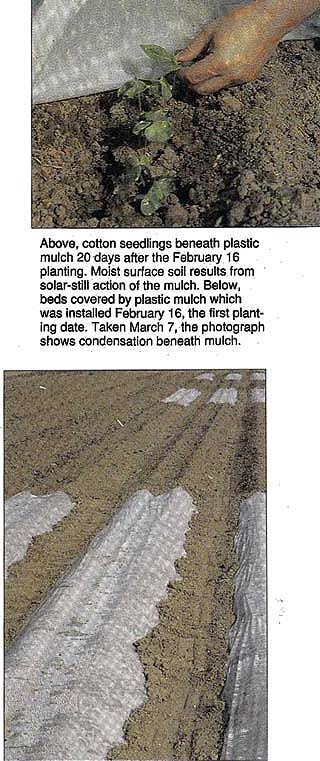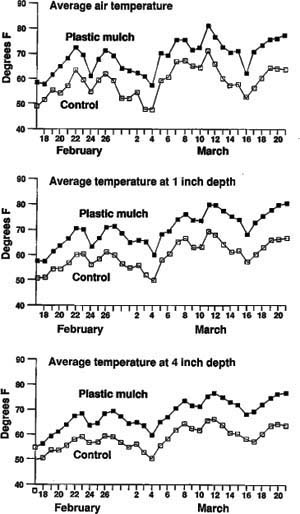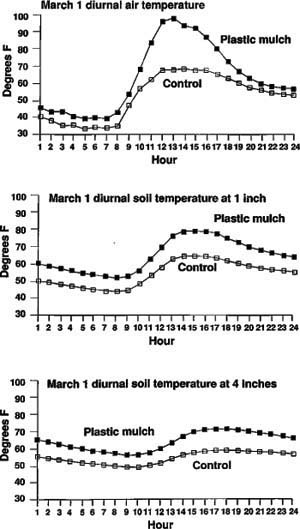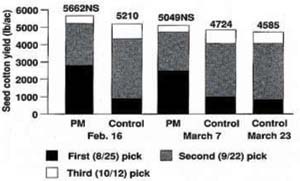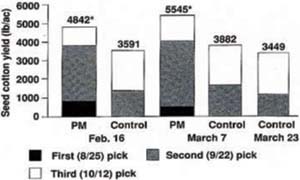All Issues
Plastic mulch increases cotton yield, reduces need for preseason irrigation
Publication Information
California Agriculture 45(3):25-28.
Published May 01, 1991
PDF | Citation | Permissions
Abstract
Preseason irrigation of cotton has been identified as the single largest contributor to the drainage problem in the central San Joaquin Valley. By applying plastic mulch at earlier than normal planting dates, we conserved soil moisture that would have normally been lost to the atmosphere. The mulch also raised soil temperatures, resulting in rapid germination and early plant growth. Yields of Pima S-6 and Acala SJ-2 were 39% and 8% higher than nonmulched plots, respectively. Net profit increased by about $450 per acre for Pima because it attracted a higher price.
Full text
Above, cotton seedlings beneath plastic mulch 20 days after the February 16 planting. Moist surface soil results from solar-still action of the mulch. Below, beds covered by plastic mulch which was installed February 16, the first planting date. Taken March 7, the photograph shows condensation beneath mulch.
California cotton growers often apply preseason irrigation to cotton to refill the potential plant root zone and to provide adequate seedbed moisture for germination. Also called preirrigation, this practice commonly involves surface irrigation methods such as furrows and has been identified as the single largest contributor to the drainage problem that affects vast areas of the central San Joaquin Valley.
Recent studies have shown that 20% to 30% of water applied with furrows during preirrigation can be lost to drainage. Drainwater disposal using evaporation ponds has resulted in serious environmental problems. Alternative irrigation such as sprinklers and drip can apply water more uniformly than surface methods, permitting better control of irrigation amounts and reducing drainage. However, new systems are expensive and rapid adoption cannot be expected. Because the bulk of cotton acreage is furrow-irrigated, near-term partial solutions to the drainage problem are likely involve this method of irrigation.
Is preirrigation essential? In view of the known environmental impacts, the inherent inefficiency of preirrigation must be weighed against its benefits. Preirrigation could be eliminated if: (1) soil moisture from sporadic winter rainfall were conserved in the beds by some technique, and (2) postplant irrigations provided adequate root-zone moisture.
Clear plastic mulch (PM) is used in other cotton-producing countries with limited season lengths to enhance earliness. Under California conditions, this technology can be used to trap soil moisture that otherwise would be lost by surface evaporation. Additionally, lengthening the growing season may allow for the more successful introduction of long-season varieties. Growers are more likely to adopt new, efficient irrigation practices if they perceive additional agronomic benefits that may increase revenue.
A study was conducted in 1989 at the University of California West Side Field Station to evaluate:
-
if cotton stand establishment without preirrigation is possible using PM,
-
how PM affects earliness,
-
effects of lengthening the growing season on short-and long-season cotton productivity, and
-
costs versus benefits of PM use in cotton production systems in California.
Experimental design
Two varieties of cotton (Acala SJ-2 and Pima S-6) were planted at three dates (February 16, March 7, and March 23) with two bed treatments — a clear strip of 36-inch-wide PM placed on top of the bed at planting and a control without the mulch. The layout was a split-split plot design with planting date, variety, and bed treatment as the main, submain, and sub-submain plots, respectively. Individual plots consisted of four beds, each 38 inches wide and 20 feet long. The inside two beds were used for soil- and plant-based measurements. Each treatment was replicated four times.
Planting on the first two dates was accomplished with a conventional tractor-mounted seeder equipped with small sweeps that formed a V-shaped notch about 4 inches deep in the middle of each bed. Due to the close proximity of the plots and potential tractor damage to the monitoring equipment, a hand-operated seeder was used on the third planting date. Seeds were planted about 1 inch deep in the bottom of the notch. The PM was installed by hand. Because the soil was not preirrigated, soil moisture came primarily from the about 4 inches of total winter rainfall that preceded planting (0.8, 2.0, 0.2, and 0.9 inches in November, December, January, and February, respectively). Rainfall in March and April totalled 0.4 inches.
After each planting, one replicate in each surface treatment and variety was instrumented with an array of continuously recording thermocouples to measure air and soil temperatures. In each array, two thermocouples were installed 0.5 inch above the soil and four thermocouples (which were averaged) were installed at both the 1- and 4-inch depths.
Several days after seedling emergence in the PM plots, holes of about 0.25-inch diameter were opened in the PM at about 12- to 15-inch intervals. More holes were made in the first and second planting because of the very high air temperatures under the plastic. Three weeks after emergence, there were holes every 4 to 6 inches in the center of the plastic sheet. With the third planting date, holes were not opened in time and inside air and 1-inch soil temperatures reached 140° and 120°F, respectively. This resulted in substantial seedling death. Therefore, the mulched plots of the third planting date were abandoned and the comparisons presented here are limited to the first and second planting dates and the controls.
Triplicate soil samples were collected in the 0- to 3-inch and 3- to 6-inch soil layers of each treatment on each planting date and soil water content by weight was determined.
Plant height and boll development were assessed prior to full cover by monitoring plants in representative 40-inch sections of each bed. Canopy development was assessed at noon on May 26 by measuring intercepted radiation with a linear sensor placed across the beds. Differences in plant cover according to planting dates and surface treatments were substantial at this time.
To evaluate earliness, the plants were harvested by hand three times. Harvest dates were August 25, September 22, and October 12. Seed cotton was collected from the middle two rows of each plot after discarding 3 feet on each side as a border.
Fig. 1. Mean daily temperatures from hourly measurements between February 17 and March 21 just above the soil surface and at two soil depths.
Fig. 2. Hourly temperature measurements on March 1 just above the soil surface and at two soil depths.
Irrigation during the season was with furrows, and timing was based on midday leaf water potential readings. On April 4, about 1.5 inches of water was applied with sprinklers to germinate seeds in the control plots. About 29 inches of water was applied over the season with the last irrigation (alternate furrows) on August 28.
Results and discussion
The threshold average daily soil temperature required for cotton germination is 55° to 60°F. At the first planting date, average soil and air temperatures were far too low for germination in the control plots. One day after the February 16 planting in the Pima control plots, the mean daily air temperature was 49.2°F with a high of 73.9°F at 1 p.m. and a low of 32.4°F at 7 a.m. However, temperature conditions beneath the PM were much more favorable. The air temperature under the plastic averaged 58.2°F with a maximum of 103.9°F at 1 p.m. The minimum PM air temperature was 34°F at 5 a.m. Accelerated soil warming occurred at both the 1-and 4-inch depths with mean temperatures of 57.6° and 55.1°F, respectively, compared with corresponding control values of 51° and 50.3°F. Mulch-induced soil warming resulted in seedling emergence under the plastic 11 days after the mid-February planting. No evidence of germination was observed in the control through the first week of March.
TABLE 1. Soil water content on dry weight basis measured In the upper layers of the profile just prior to planting in the control plots
Soil temperatures in the control plots increased by March 7 to levels exceeding the 60°F threshold (figs, 1a to 1c). However, no germination occurred due to low soil moisture in the seedbed (table 1). Soil water content in the top 3 inches of the profile decreased by almost 7% on a dry-soil-weight basis (equivalent to about 1.1 inches of water per foot of soil using a representative soil bulk density value) between February 16 and March 7 due to evaporation from the soil surface.
This rapid decline in soil moisture in the seed planting zone was enhanced by the absence of any preplant irrigation and the relatively low winter rainfall. This condition in the control plots existed through the March 23 planting. The April 4 sprinkler irrigation was used to obtain germination.
Although the same relatively dry soil conditions on the second and third planting dates were present in the PM plots, the plastic acted as a solar still which increased bed moisture to the point that seeds germinated within 7 days of planting. Water vapor evaporating from the soil profile condensed on the underside of the plastic and water droplets were deposited directly over the shallow-planted seeds. This action conserved the soil water that would otherwise have been lost to the atmosphere and allowed for early seedling development. The resulting conservation of winter rainfall made preirrigation unnecessary for germination in the PM plots.
Air temperatures under the mulch during early March continued to reach high maximum values relative to the control while minimum temperatures were similar (fig. 2a). The much warmer air temperatures between 10 a.m. and 5 p.m. promoted rapid plant development and considerably lengthened the growing season. As shown in figures 2b and 2c, warmer soil temperatures were maintained throughout the day, illustrating the soi's ability to store heat, presumably enhancing root development.
Faster plant development due to the PM is evident by comparing early season plant height, fruiting density, and solar radiation intercepted by the canopy (table 2). On May 26, the plants were about 50% taller in the PM than in the control plots. Although no squares were present in the control plots through May 26, significant fruiting had already occurred with the PM. The rate of early season Pima fruiting exceeded that of Acala by about a factor of two. Light interception by the canopy was much greater for the PM plants.
Crop yield and earliness
The longer season achieved using PM resulted in earlier and higher cotton yields (figs. 3a and 3b). The magnitudes of the differences relative to the controls were variety-dependent. For the February 16 planting, PM yields of Acala seed cotton were about 450 pounds per acre greater than those of the control (fig. 3a). The bolls matured much earlier; yields for the first pick (August 25) were three times greater in the PM plots. Acala yield differences for the March 7 planting narrowed to about 300 pounds per acre of seed cotton in favor of the PM. Earliness in the PM plots for the second planting date was very similar to that of the February 16 planting (fig. 3a).
Yield increases effected by the PM were much greater for Pima than for Acala (fig. 3b). For the February 16 and March 7 plantings, PM yields were about 1,250 and 1,700 pounds per acre of seed cotton greater than the control, respectively. These differences are significant at the 5% confidence level. Even though Pima is clearly a longer season variety than Acala, the PM accelerated maturity such that about 20% and 10% of the total seasonal yield was picked on August 25 for the first and second planting dates, respectively. At this first pick, there were no open bolls in the control plots.
The larger Pima yield differences relative to Acala are presumably due to the growth habit of Pima; a less determinate, longer season variety. Note that growing conditions in the San Joaquin Valley in 1989 (a warm early spring and moderate summer temperatures) were considered nearly ideal for both Acala and Pima. These conditions diminish the impact of practices that lengthen the season, such as PM. This suggests that during years of less favorable weather, yield differences between PM and conventional planting would be greater, especially with longer season varieties.
Cost-benefit analysis
To estimate the economic impact of PM usage in this test, we averaged the PM yields of the February 16 and March 7 plantings and compared this with the March 23 planted control (table 3). A gin turnout of 32% and lint prices of $0.65 and $1.10 for Acala and Pima, respectively, were assumed in calculating gross revenue. We conservatively estimated that the cost of the PM material, installation, and maintenance would be $160 per acre when done on a large-scale basis. Using these assumptions we calculated increased net revenues to plastic-mulched Pima and Acala cotton, in which the yield increases were about 1.1 and 0.5 bales per acre, respectively, using 500-pound bales. Higher yields led to increased net revenues of close to $500 per acre for the Pima, but produced little economic benefit for the Acala.
Fig. 3a. Yield and earliness of Acala for the three planting dates. A number followed by NS indicates no significant difference at the 5% confidence level from the control for that planting date.
Fig. 3b. Yield and earliness of Pima for the three planting dates. A number followed by an asterisk indicates significant difference at the 5% confidence level from the control for that planting date.
This analysis does not include any water cost savings that might occur if preirrigation is eliminated in favor of presumably more efficient postplant irrigation. Cotton net water requirements in the San Joaquin Valley are an estimated 29 to 31 inches. Our irrigation application of 29 inches most likely led to very low drainage losses.
Additional considerations
Growers are currently prohibited from planting cotton before March 20 in the southern San Joaquin Valley to maintain a 120-day host-free period for the pink boll-worm. Preventing this insect from becoming established in this area is a high priority for the cotton industry. Due to this mandated host-free period, planting with PM to use the early part of the growing season may not be feasible at the time.
Weed control under PM can be a significant problem, but control has been achieved with herbicide programs now in use in several Mediterranean countries. Adaptive research and registration is needed in California to develop weed control practices for use with PM.
The PM used in this test is a petroleum-based product. Although this material is photodegradable, and, we presume, slowly biodegradable, the energy and sustainability aspects of PM usage need to be established. Additionally, potential lint contamination problems at the gin need to be considered.
Research indicates that under certain conditions, the use of deep-buried (12 to 24 inches) drip irrigation lines in cotton production offers significant water conservation advantages over other irrigation methods. One of the unsolved problems with deep-buried drip is how to effectively preirrigate. When lateral lines are located only under every other bed or furrow, large quantities of water may have to be applied before there is sufficient upward and lateral movement of water into all the beds to provide for germination. These excessive applications may result in deep percolation.
Installing drip lines under every furrow or bed may not be economically feasible. Although it has been suggested that growers use other systems for preirrigation, such as sprinkler or furrow systems, adoption of dual systems cannot be expected. However, the use of PM appears to offer a solution to the buried drip problem. In an extremely dry winter, a small application of water using the buried drip system could be used.
Conclusions
The use of PM conserves soil moisture that would normally be lost to the atmosphere. This trapped moisture is redistributed in the seedbed and allows for germination. With only small amounts of winter rainfall, the need for preplant irrigation is precluded. Delaying the first irrigation to the postemergence period should also lead to more efficient irrigation due to lower infiltration rates, the latter a result of field traffic. Subsequent irrigations should be carefully managed in the absence of a fully charged profile, and agronomic problems — such as possible enhancement of moisture- and temperature-related soil-borne diseases and disruption of early season cultural operations — must be considered. Because preirrigation is usually a wasteful irrigation practice even for the best surface irrigator, utilizing winter rainfall or soil moisture carryover from the previous season by using PM should lead to reduced drainage losses in the San Joaquin Valley.
The use of PM promotes rapid germination and early growth of cotton as long as excessive air and soil temperatures are avoided. This allows for earlier boll maturation and harvest. Although this may not be critical to short-season, determinate varieties such as Acala, effectively lengthening the growing season enhances production of late-maturing varieties, such as Pima S-6, which currently fetch higher prices. The use of this longer season variety appears to make the use of PM cost-effective in the southern San Joaquin Valley.




